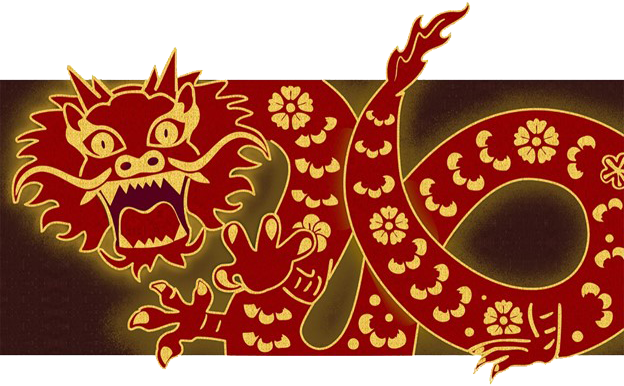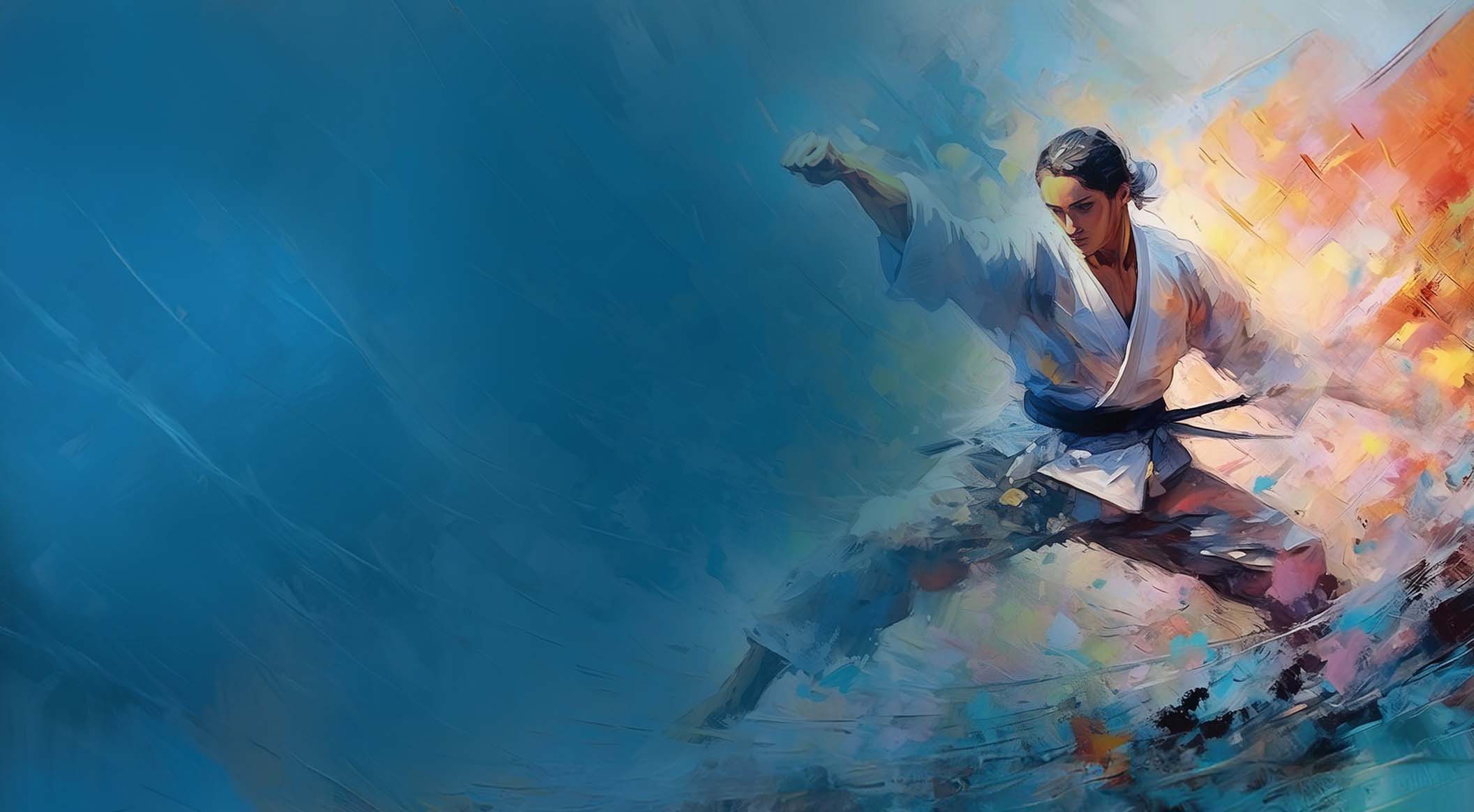A Glimpse Of Old Karate From Hohan Soken
By Christopher Caile
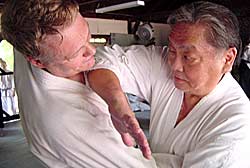 |
Suenaka executes an elbow technique to Christopher Caile's jaw in demonstrating a close quarter technique that Hohan Soken taught him. |
I am a student of Seido Karate under Kaicho Tadashi Nakamura in New York City. But I am a karate historical buff too, so I am always interested in the karate practiced in Okinawa before modern influences, when karate was practiced for self-defense.
One of my portals into this world is through my aikido instructor Roy Suenaka Sensei, who was also a long time student of the great Okinawan karate master Hohan Soken. Soken traced his techniques to one of the most famous and influential Suri (capital of Okinawa) masters Bushi (Sokon) Matsumura (1762-1843) from which much of modern Okinawan Shorin-ryu karate was influenced. (1) He was body guard to the King of Okinawa and martial arts instructor and official of the Ryukyu Kingdom. From his teaching a whole generation of masters emerged.


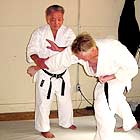
Here Roy Suenaka demonstrates a technique against a straight punch to the head performed by Christopher Caile. The photo at left shows the hand position — the left hand parries across the body similar to how a boxer might parry a jab. Along with the parry Suenaka slides forward and to the outside of the punch as the right arm and open hand shoots forward and upward under the attacking arm (creating a uneven "X" technique). The forearm of the right arm and the left palm parry briefly interrupt and catch the punch. A close up of this is seen in the next photo. Notice the right hand is above the attacking arm. The right open hand then folds (not shown) over the attacking arm's wrist and pulls down. The photo at right shows an arm bar that can naturally follow this technique. This controls and ends the attack. There are many other follow-up options.

Alternative follow ups to the above technique include a punch to the ribs as shown here, or to the face. A variety of knee techniques and kicks are other options. The key to this technique is that you get outside the opponent and control the attacking arm to give you a position of advantage (your opponent also being off balanced) from which many follow up techniques can be launched. A key principle here is controlling the attacker's arm from the outside toward his middle, also known as "closing down" an attack.
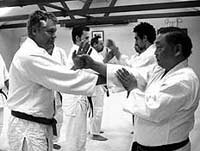
Roy Suenaka also demonstrates a useful drill that stems from this initial capture. Christopher Caile is his partner. After the right hand captures and pulls the punch down as in the sequence above, the left arm parries the punching arm down while the right hand counters with a punch to the head. The opponent now parries that punch with his left palm and moves his right forearm under the punch as in the initial block. This parry/capture, right counter as you down parry with your left continues back and forth. With practice speed increases until the technique becomes just a blur to any observer. These type of two man drills can be very useful since they ingrain responses into muscle memory and reflexive action so they will come out naturally when, and if, ever needed.
Suenaka studied directly with Hohan Soken as a private student for eight years while based on Okinawa with the US military. So when I visit with him to study aikido, I always prompt him to demonstrate techniques that Soken himself used. Since Suenaka also teaches Soken's karate heritage, he usually obliges. I've been doing this for 18 years.
I find Soken's teachings especially interesting because they provide a look back to old style Okinawan karate that was both practical and effective. "Soken himself always used soft blocks, and flowing techniques," says Suenaka " although he taught us hard blocks too." Hard blocks were for youth and they toughened you up, he would say, but as you got older, "Soken would say, "you should do softer techniques."
This reflected I think Soken's own teaching.
Students of Soken began with hard style Shorin Ryu karate and then after lengthy training they would be introduced to his family art within an art, or White Crane. White Crane's techniques, especially blocks are often soft, and the techniques are flowing. Movement is angled and combined blocking, trapping and counters. Most often the hand were open, and fingertip techniques were often used,.
As Hohan Soken often said with these techniques "Uki Ti Boom." "Uki Ti" means block in Okinawan dialect (Hogan) and "Boom" is an English expression Soken picked up somewhere from Americans. It signified a single technique counter that ended an attack.
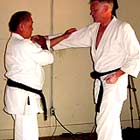


This sequence demonstrates another key principle of defense –opening up a defender, meaning to control an attack from the inside outward to open the attacker's center line. In this attack, Christopher Caile executes a rounded outside punch to Suenaka Sensei's head. The punch is intercepted by Suenaka's left arm, that is slightly bent, the outside of the open hand striking into the elbow region of the attacker's arm. At the same time Suenaka's right palm crosses his body to execute a palm block against the fist of the attacking arm. A slight koshi action propels the left arm (more on this later). The unbendable left arm position is very strong and will stop an attack in its tracks. At the same time Suenaka Sensei shifted his body (either back and to the right slightly or forward into the attack depending on the punch and positon). But seen by an observer this does not look like a hard block typical of an open hand block, because immediately upon contact the finger's of the left open hand loop over the elbow of the attacking arm and pull the arm forward and slightly to the outside. This off-balances the opponent. Just as with the former technique, this block and trap sets up any number of follow up techniques. The next photo shows a right elbow counter to the attacker's head. An alternative and a technique often demonstrated by Soken is a finger technique to the throat.

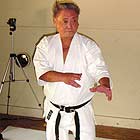

Left: The photo shows a hand position that Soken often used. Notice the two first fingers are held slightly separated to be used in a follow up counter.
Center: The photo demonstrates one of Soken's typical guard postions.
Right: Here the follow-up technique is a finger technique against the attacker's shoulder area (in the crease of the shoulder). If the finger counter is done with power it strikes a vulnerable point and can paralyze the arm. But the most important effect is that it (when combined with a pull of the left arm) pulls the opponent off balance to the side and back.
In the two self-defense sequences demonstrated above, the initial goal is to avoid getting hit, but also to control the initial attack .It also avoids the problem of a continued attack. This requires quick decisive action against the initial move. Just a defensive block, parry or other move is not enough. Thus in many ways Soken's White Crane strategy (and that found in much of traditional karate kata) parallels that of aikido — control of the initial attack, although in aikido the goal is not to hurt the attacker.
These illustrations also highlight trapping and grabbing techniques drawn from White Crane, something little practiced today. In fact most modern karate, especially sports karate, often limit or bar the use of grabs and traps. Of course, the necessity of wearing hand protectors and gloves makes these techniques very difficult to do. I think this is a great loss and this changes the very nature of karate self-defense. Instead of physically controlling the opponent, the karate practitioner is left with a more difficult effort – controlling the space between himself and his opponent. This is what a boxer does and it is much more difficult to limit continuous attacks. If you don't capture/grab or control an attack the opponent's balance isn't broken or his position is physically controlled. This makes countering more difficult, Sure you can angle, move back and forth, but your options are more limited.
These same trapping, grabbing and off-balancing techniques are also seen in many kata. In fact they are one key to understanding kata applications and their self-defense strategies and principles. (2)
Soken's soft techniques are also quite practical. If an attacker is close and you don't know what attack is coming it is virtually impossible to do a hard block (if the attacker has to step forward to attack you have more time and a hard block is possible). In boxing, for example, when an opponent throws a jab at your head the defender can slip the punch (moving his head out of the way) or use the palm of his hand to parry the punch to the inside. Since the punch is so fast, little strength can be put into the parry. Interestingly this same type of parry is used in the Soken techniques illustrated above. But instead of a counter jab which a boxer might use, Soken fires out the same arm (as a boxer's counter jab), open handed to stop and capture the attacking arm.
Another aspect of Soken's karate which can be traced back to his White Crane is the use of koshi (the hips, upper thigh and lower abdomen area).
There are a few videos out there of Hohan Soken doing kata in his later years, but you don't really see his footwork or koshi movement. Perhaps it had internalized to the extent that it was unnoticeable, or Soken at his age wasn't able to ably perform these movements well, or perhaps he just didn't care to show this on film.
In any case when you look at Suenaka's techniques you see a distinct type of power generation, not the sequential rotation of body segments that characterize most of Japanese karate, but instead a koshi twitch that whips out techniques. This parallels similar action as shown by White Crane Kung Fu exponents and some styles of old Okinawan Shorin-ryu karate (3).
Hohan Soken (1889-1982)
|
Roy Suenaka Sensei
|
Footnotes:
(1) The dates of Bushi Matsumura's birth and death are uncertain. Various dates are given by different historians,
(2) Trying to discuss kata in terms of general statements is very difficult since
different kata were developed for different purposes – some for self-defense, some
for basics, some of competition (to look good), some to teach counters to grabs, etc.
(3) An example is Dr. Yang, Jwing-Ming whose White Crane technique uses similar action. Although Dr. Yang teaches his power transmission in a unique fashion, the end results are similar. On Okinawa, most old style karate teachers never explained movement. Usually instruction went like, "Do it like this." Some students got it, others did a little and others often missed the essentials. This was the case of Seigi Nakamura who was chief instructor under Shoshin Nagamini Sensei (founder of Matsubayashi Shorin-Ryu Karate) who had similar koshi whipping action. It should be said, however, that in his early postwar dojo, many practitioners from different teaching lineages all practiced together. Thus there were also differences in interpretation of movement. Over time, however the close personal supervision required to teach this old style koshi movement was lost to bigger classes and to simpler Japanese-like power development methods. Nagamine, however, had asked one of his senior students to study with Hohan Soken for a period, a study that expanded into nine years. This student Chogi Kishaba Sensei (who married Nagamine's niece or grand niece), later diverged and formed his own allied group to develop methods to teach these old koshi methods. The organization is called Kishaba Juku Shorin Ryu Karate. The organization is now headed by Katsuhiko Shinzato Sensei in Okinawa, a senior US representative being George Donahue, a friend and writer for FightingArts.com. While differences exist in some details of power generation there are great similarities in how the koshi is used between what I see with Suenaka and what Kishiba Juku practitioners do. Interestingly too I see similar koshi movement and figure 8 rotation around the stances in the Tai Chi demonstrated by my Chi Kung (a branch of Chinese medicine) teacher, Dr. Zaiwen Shen, who also teaches tai chi (as well as Ba qua, or Pa Kua and Hsing-i). One of our Tai Chi Chi Kung exercises practices this foot and koshi rotation pattern, something I had practiced for years before becoming acquainted with Hohan Soken, White Crane or Kishaba Juku.
About the Author Christopher Caile

Screenshot
Christopher Caile is the Founder and Editor-In-Chief of FightingArts.com. He has been a student of the martial arts for over 65 years.
He first started in judo while in college. Then he added karate as a student of Phil Koeppel in 1959 studying Kempo and Wado-Ryu karate. He later added Shotokan Karate where he was promoted to brown belt and taught beginner classes. In 1960 while living in Finland, Caile introduced karate to that country and placed fourth in that nation's first national judo tournament.
Wanting to further his karate studies, Caile then hitch hiked from Finland to Japan traveling through Scandinavia, Europe, North Africa, the Middle East and South and Southeast Asia — living on 25 cents a day and often sleeping outside.
Arriving in Japan (1962), Caile was introduced to Mas Oyama and his fledgling full contact Kyokushinkai Karate by Donn Draeger, the famous martial artist and historian. Donn also housed him with several other senior international judo practitioners. Donn became Caile's martial arts mentor, coaching him in judo and introducing him to Shinto Muso-ryu under Takaji Shimizu.
Caile studied at Oyama's honbu dojo and also at Kenji Kurosaki's second Tokyo Kyokushinkai dojo. In his first day in class Oyama asked Caile to teach English to his chief instructor, Tadashi Nakamura. They have been friends ever since. Caile also participated in Oyama's masterwork book, "This Is Karate."
Caile left Japan with his black belt and designation as Branch Chief, the first in the US to have had extensive training in Japan directly under Oyama Sensei. As such, Oyama Sensei asked him to be his representative on visits to his US dojos to report on their status.
A little over a year later, Nakamura, Kusosaki and Akio Fujihira won an epic David vs. Goliath challenge match against Thailand's professional Muay Thai Boxers in Bangkok, Thailand, thrusting Kyolushinkai and Nakamura into national prominence.
Back in the US Caile taught Kyokushinkai karate in Peoria, Il while in college and later in Washington, DC. while in graduate school. Durimg this time Shihan Nakamura had moved to New York City to head Kyokushinkai's North American Operation.
In 1976 when Kaicho Tadashi Nakamura formed the World Seido Karate organization, Caile followed. Living then in Buffalo, NY, Caile taught Seido karate and self-defense at the State University of New York at Buffalo (SUNY Buffalo) for over 15 years where he also frequently lectured on martial arts and Zen in courses on Japanese culture.
Caile moved to New York City in 1999 to marry Jackie Veit. He is now an 8th degree black belt, Hanshi, training in Seido Karate's Westchester, NY Johshin Honzan (Spiritual Center) dojo. In Seido Caile is known for his teaching of and seminars on kata applications. He also produced a 14 segment video series on Pinan kata Bunkai currently available to Seido members.
Caile is also a long-time student and Shihan in Aikido. He studied in Buffalo, under Mike Hawley Shihan, and then under Wadokai Aikido's founder, the late Roy Suenaka (uchi deshi under Morihei Ueshiba, founder of Aikido and was Shihan under Tohei Sensei). In karate, Suenaka (8thdan) was also an in-house student of the Okinawan karate master Hohan Soken.
Having moved to New York City, Caile in 2000 founded this martial arts educational website, FightingArts.com. Twenty-five years later, in 2025, it underwent a major update and revision.
For FightingArts.com and other publications Caile wrote hundreds of articles on karate, martial arts, Japanese art, Chinese Medicine and edited a book on Zen. He also developed relationships with a cross section of leading martial arts teachers. Over the last four decades he has conducted extensive private research into karate and martial arts including private translations of the once secret Okinawan hand copied and passed on Kung Fu book, the Bubishi, as well as an early karate book by the karate master Kenwa Mabuni. He periodically returns to Japan and Okinawa to continue his studies and participate Seido karate events. In Tokyo he practiced (with Roy Suenaka Sensei) in a variety of aikido organizations with their founders – including private interviews and practices at the Aiki-kai Aikido Honbu dojo with the son and grandson of aikido's founder, Doshu (headmaster) Kisshomaru (an old uchi-deshi friend) and his son, Moriteru Ueshiba and in Iwama with Morihiro Saito. On Okinawa he studied Goju Ryu karate under Eiichi Miyazato, 10th dan founder of Naha's Jundokan, and also with Yoshitaka Taira (who later formed his own organization, who specialized in kata Bunkai. While there Caile also trained with Hohan Soken's senior student, Master Fusei Kise, 10 dan as well as with the grandson of the legendary karate master Anko Itosu.
Caile's other martial arts experience includes: Diato-ryu Aikijujitsu and Kenjitsu, kobudo, boxing, Muay Thai, MMA, Kali (empty hand, knife and bolo), study of old Okinawan Shoran-ryu & Tomari body mechanics, study of old Okinawan kata under Richard Kim, study of close quarter defense and combat, including knife and gun defenses, Kyusho Jitsu and several Chinese fighting arts including 8 Star Praying Mantis, Pak Mei (White Eyebrow), and a private family system of Kung Fu.
Caile is also a student of Zen as well as a long-term student of one branch of Traditional Chinese Medicine, Chi Kung (Qigong). As one of two senior disciples of Chi Kung master Dr. Shen (M.D., Ph.D.) Caile was certified to teach and practice. This led to Caile's founding of the The Chi Kung Healing Institute on Grand Island, NY. In Western NY, he also frequently held Chi Kung seminars, including at SUNY Buffalo and at the famous Chautauqua Institution in Chautauqua, NY. His articles on Chi Kung also appeared in the Holistic Health Journal and in several books on alternative medicine.
Caile holds a BA in International Studies from Bradley University and MA in International Relations with a specialty in South and Southeast Asia from American University in Washington, D.C. While in Buffalo, NY he also studied digital and analog electronics.
In his professional life Caile also worked in public relations and as a newspaper reporter and photographer. Earlier he worked in the field of telecommunications including Managing a Buffalo, NY sales and service branch for ITT. He then founded his own private telephone company. This was followed by creation of an electrical engineering company that designed and patented his concept for a new type of low-cost small business telephone system (which was eventually sold to Bell South). The company also did contract work for Kodak and the US space program. Simultaneously Caile designed and manufactured a unique break-apart portable pontoon boat.
Most recently Caile co-founded an internet software company. Its products include software suites with AI capability for control and management of streaming media, such as video and music, an all-in-one book publishing software product for hardcover, eBook and audio book creation and security software for buildings and government use.
For more details about Christopher Caile's martial arts, work experience and life profile, see the About section in the footer of this site.
Search for more articles by this author:
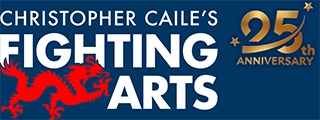

 Soken was born into a noble family that lost wealth and position with the abolishment of the Okinawan feudal system. His lineage traced back to the famous Bushi Matsumura, the famous Suri (Okinawa's capital) karate master and body guard to the King of Okinawa. Even as a child Soken was forced to work menial jobs to subsist. At the age of 13 he began his karate training. He worked the fields during the day. At night he trained under his uncle Nabe Matsumura (grandson of Bushi Matsumura). Ten years later and hardened by training, Nabe told Soken that he was ready to learn the secret family system within the outer hard system he had been studying — Hakutsuru or "White Crane," a system distinctly Chinese with flowing soft movements. During this time Soken also studied weapons under Chikin Kraka and eventually became one of the top Kobudo practitioners on Okinawa. Unhappy with the Japanese absorption of Okinawa into the mainland, and refusing to learn Japanese (preferring the Okinawan dialect he spoke), Soken moved to Argentina in 1920 where there was an active Okinawan community. He returned to Okinawa in 1946. Away from Okinawan karate, Soken's karate retained its original form away from modernizing influences, a sort of time capsule revealing older ways. He became one of the oldest and most respected Shorin-ryu teachers on Okinawa teaching out of his home dojo.
Soken was born into a noble family that lost wealth and position with the abolishment of the Okinawan feudal system. His lineage traced back to the famous Bushi Matsumura, the famous Suri (Okinawa's capital) karate master and body guard to the King of Okinawa. Even as a child Soken was forced to work menial jobs to subsist. At the age of 13 he began his karate training. He worked the fields during the day. At night he trained under his uncle Nabe Matsumura (grandson of Bushi Matsumura). Ten years later and hardened by training, Nabe told Soken that he was ready to learn the secret family system within the outer hard system he had been studying — Hakutsuru or "White Crane," a system distinctly Chinese with flowing soft movements. During this time Soken also studied weapons under Chikin Kraka and eventually became one of the top Kobudo practitioners on Okinawa. Unhappy with the Japanese absorption of Okinawa into the mainland, and refusing to learn Japanese (preferring the Okinawan dialect he spoke), Soken moved to Argentina in 1920 where there was an active Okinawan community. He returned to Okinawa in 1946. Away from Okinawan karate, Soken's karate retained its original form away from modernizing influences, a sort of time capsule revealing older ways. He became one of the oldest and most respected Shorin-ryu teachers on Okinawa teaching out of his home dojo. Roy Suenaka Sensei while stationed in the US armed forces on Okinawa was a direct private student of Grandmaster Hohan Soken Sensei for eight years on Okinawa. He continues Hohan Soken's legacy through his karate organization, Matsumura Seito Hakutsuru Shorin-ryu Karate-do and Kobudo. The last living direct teacher of this style was Soken, who during his life was considered the greatest karate teacher on Okinawa. Suenaka was also a student of aikido under Koichi Tohei (the great student of the art's founder) starting in 1953 in Hawaii and later with Morihei Uyeshiba, O-Sensei, the founder of aikido in Japan at the Aikikai Hombu for eight years, beginning in 1961. Suenaka was the first to open a successful aikido dojo in Okinawa. Soken too was interested in the art, having found its moves similar in many ways to the White Crane that he taught. Suenaka holds an 8th dan in both aikido and karate, as well as a 3rd dan in judo and a 2nd dan in kendo. He now resides in Charleston, S.C., He is the author of the best-selling Complete Aikido, and in 2003 celebrated his 50th year of martial arts study.
Roy Suenaka Sensei while stationed in the US armed forces on Okinawa was a direct private student of Grandmaster Hohan Soken Sensei for eight years on Okinawa. He continues Hohan Soken's legacy through his karate organization, Matsumura Seito Hakutsuru Shorin-ryu Karate-do and Kobudo. The last living direct teacher of this style was Soken, who during his life was considered the greatest karate teacher on Okinawa. Suenaka was also a student of aikido under Koichi Tohei (the great student of the art's founder) starting in 1953 in Hawaii and later with Morihei Uyeshiba, O-Sensei, the founder of aikido in Japan at the Aikikai Hombu for eight years, beginning in 1961. Suenaka was the first to open a successful aikido dojo in Okinawa. Soken too was interested in the art, having found its moves similar in many ways to the White Crane that he taught. Suenaka holds an 8th dan in both aikido and karate, as well as a 3rd dan in judo and a 2nd dan in kendo. He now resides in Charleston, S.C., He is the author of the best-selling Complete Aikido, and in 2003 celebrated his 50th year of martial arts study.
